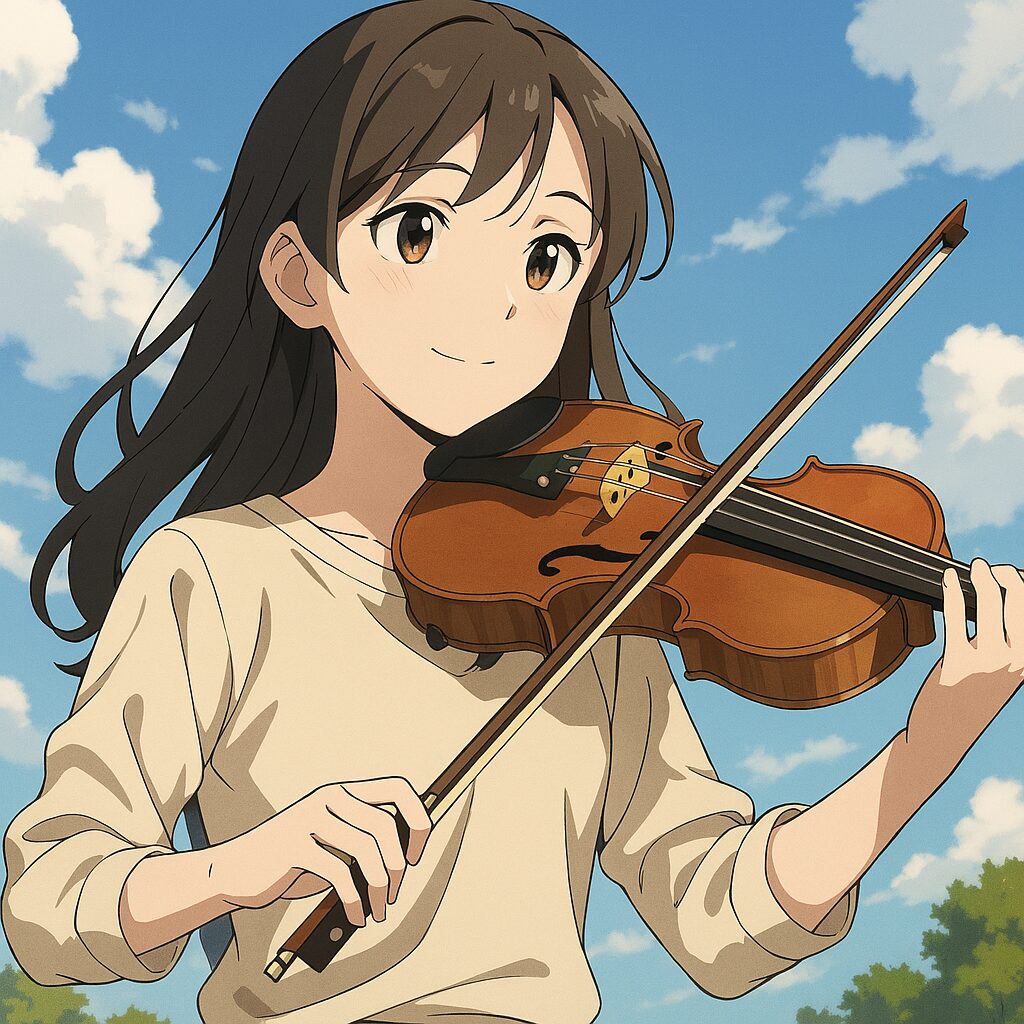- Why Is August 28 Called “Violin Day”?
- 🎼 What Is a Violin? — A Symbol of Western Music
- 🇯🇵 When the Violin First Came to Japan
- 🛠️ A Shamisen Craftsman’s Challenge
- 🎶 The Growth of Violin Culture in Japan
- 🌏 For Global Readers — The Philosophy Behind Japanese Craftsmanship
- ✨ Conclusion: What Violin Day Teaches Us
- はじめに:なぜ「バイオリンの日」なのか?
- 🎼バイオリンとは?──西洋音楽の象徴
- 🇯🇵日本にバイオリンがやってきた頃
- 🛠️三味線職人が挑んだ異文化の楽器
- 🎶日本のバイオリン文化の広がり
- 🌏海外の読者へ──日本の職人文化と音の哲学
- ✨まとめ:音の記念日が教えてくれること
Why Is August 28 Called “Violin Day”?
August 28 marks “Violin Day” in Japan. This commemorative day honors the achievement of Sadajiro Matsunaga, a shamisen craftsman from Fukagawa, Tokyo, who completed Japan’s first domestically made violin in 1880 (Meiji 13).
At a time when Western music was still considered exotic, Matsunaga’s bold attempt to recreate a foreign instrument using traditional Japanese techniques became a symbol of cultural curiosity and craftsmanship.
🎼 What Is a Violin? — A Symbol of Western Music
The violin originated in 16th-century Italy and has become one of the most beloved instruments in classical music. Its expressive tone and versatility make it ideal for solo performances, ensembles, and orchestras.
- Four strings (G, D, A, E)
- Played by drawing a bow across the strings
- Used in classical, folk, and even pop music
Its sound is often described as closest to the human voice, capable of expressing joy, sorrow, longing, and passion.
🇯🇵 When the Violin First Came to Japan
During the Meiji era, Japan underwent rapid modernization. Western clothing, architecture, and music were introduced as symbols of progress.
At that time, violins were expensive imports. Yet Sadajiro Matsunaga, a skilled shamisen maker, decided to build one himself. He studied the structure of Western violins, experimented with materials, and eventually succeeded in crafting Japan’s first violin.
His journey was one of trial, error, and deep respect for both tradition and innovation.
🛠️ A Shamisen Craftsman’s Challenge
| Feature | Shamisen | Violin |
|---|---|---|
| Number of Strings | 3 | 4 |
| Sound Production | Plucked with a plectrum | Bowed with horsehair |
| Materials | Wood (e.g., redwood) + cat skin | Wood (maple, spruce) + horsehair |
| Sound Character | Rhythmic and percussive | Melodic and fluid |
Matsunaga applied his knowledge of shamisen acoustics to a completely foreign instrument. His work bridged cultures through sound and craftsmanship.
🎶 The Growth of Violin Culture in Japan
More than 140 years later, Japan has produced world-class violinists and luthiers.
- Taro Hakase — known for his passionate performances and crossover appeal
- Midori Goto — internationally acclaimed classical violinist
- Japanese-made violins — crafted in regions like Nagano and Shizuoka
Violins are now part of school music programs and cultural festivals, showing how deeply they’ve rooted in Japanese society.
🌏 For Global Readers — The Philosophy Behind Japanese Craftsmanship
Japanese craftsmanship values the beauty of what cannot be seen — the subtle, the quiet, the refined. This philosophy resonates with the violin’s delicate nature.
- Beauty in resonance and silence
- Warmth of handmade work
- Respect for natural materials
For international readers, this story offers a glimpse into how Japan embraces foreign ideas while honoring its own traditions. Violin Day is more than a musical milestone — it’s a celebration of empathy through sound.
✨ Conclusion: What Violin Day Teaches Us
Violin Day is not just about an instrument. It’s about a craftsman who dared to cross cultural boundaries, blending East and West through sound.
Music connects hearts beyond language. Craftsmanship connects generations beyond time.
On August 28, take a moment to listen. Somewhere, the echo of a handmade violin from a Tokyo workshop may still be playing in the wind.
🎻8月28日は「バイオリンの日」──日本に響いた西洋の音色と職人の夢
はじめに:なぜ「バイオリンの日」なのか?
8月28日は「バイオリンの日」。この記念日は、1880年(明治13年)に東京・深川の三味線職人・松永定次郎氏が、日本で初めて国産バイオリンを完成させたことに由来しています。
西洋音楽がまだ「舶来品」として遠い存在だった時代に、和楽器の職人が挑んだ異文化への架け橋。その物語は、音楽だけでなく、日本人の創造力と柔軟性、そして文化の融合の美しさを教えてくれます。
🎼バイオリンとは?──西洋音楽の象徴
バイオリンは、16世紀のイタリアで誕生した弦楽器。その繊細な音色と表現力の豊かさから、クラシック音楽の中心的存在として世界中で愛されています。
- 弦は4本(G・D・A・E)
- 弓で弦をこすって音を出す
- ソロ演奏からオーケストラまで幅広く活躍
その音色は「人間の声に最も近い」とも言われ、喜び、悲しみ、祈り、情熱──あらゆる感情を奏でることができます。
🇯🇵日本にバイオリンがやってきた頃
明治時代、日本は急速な西洋化の波に乗っていました。鉄道、洋服、建築、そして音楽もまた、文明開化の象徴として注目されていました。
しかし、当時の日本にはバイオリンを製作する技術も材料もなく、すべてが輸入品。そんな中、三味線職人・松永定次郎氏が「自分の手で作ってみよう」と挑戦したのです。
彼は西洋の楽器を分解し、構造を研究し、試行錯誤を重ねて完成させました。その情熱と探究心は、まさに“音の職人魂”です。
🛠️三味線職人が挑んだ異文化の楽器
| 特徴 | 三味線 | バイオリン |
|---|---|---|
| 弦の数 | 3本 | 4本 |
| 音の出し方 | 撥(ばち)で弾く | 弓でこする |
| 材料 | 木材(紅木など)+猫皮 | 木材(メープル、スプルースなど)+馬毛 |
| 音色 | 鼓動のような打音 | 滑らかで歌うような旋律 |
松永氏は、三味線の構造や音響の知識を活かしながら、未知の楽器に挑みました。その姿は、まるで文化の境界を越えて音を紡ぐ“橋渡し人”のようです。
🎶日本のバイオリン文化の広がり
松永氏の挑戦から約150年。今では日本にも世界的なバイオリニストや製作家が多数存在します。
- 葉加瀬太郎:情熱的な演奏で知られる人気バイオリニスト
- 五嶋みどり:国際的に活躍するクラシック界の巨星
- 日本製バイオリン:長野県や静岡県などで職人が製作
また、学校教育でもバイオリンが導入されるなど、音楽の裾野は広がり続けています。
🌏海外の読者へ──日本の職人文化と音の哲学
日本の職人文化には、「見えない美」を追求する精神があります。それは、バイオリンのような繊細な楽器にも通じるもの。
- 音の余韻に宿る美
- 手仕事の温もり
- 材料への敬意
こうした価値観は、海外の読者にとっても新鮮で魅力的に映るはずです。「音を通じて心を通わせる」──それが、バイオリンの日に込められたメッセージなのかもしれません。
✨まとめ:音の記念日が教えてくれること
バイオリンの日は、単なる楽器の記念日ではありません。それは、日本人が異文化に敬意を払いながら、自らの手で新しい音を生み出した日。
音楽は言葉を超えて心をつなぐもの。そして、職人の手仕事は文化を未来へとつなぐもの。
8月28日、あなたも耳を澄ませてみませんか?遠い昔、深川の工房で生まれた一音が、今もどこかで響いているかもしれません。



コメント